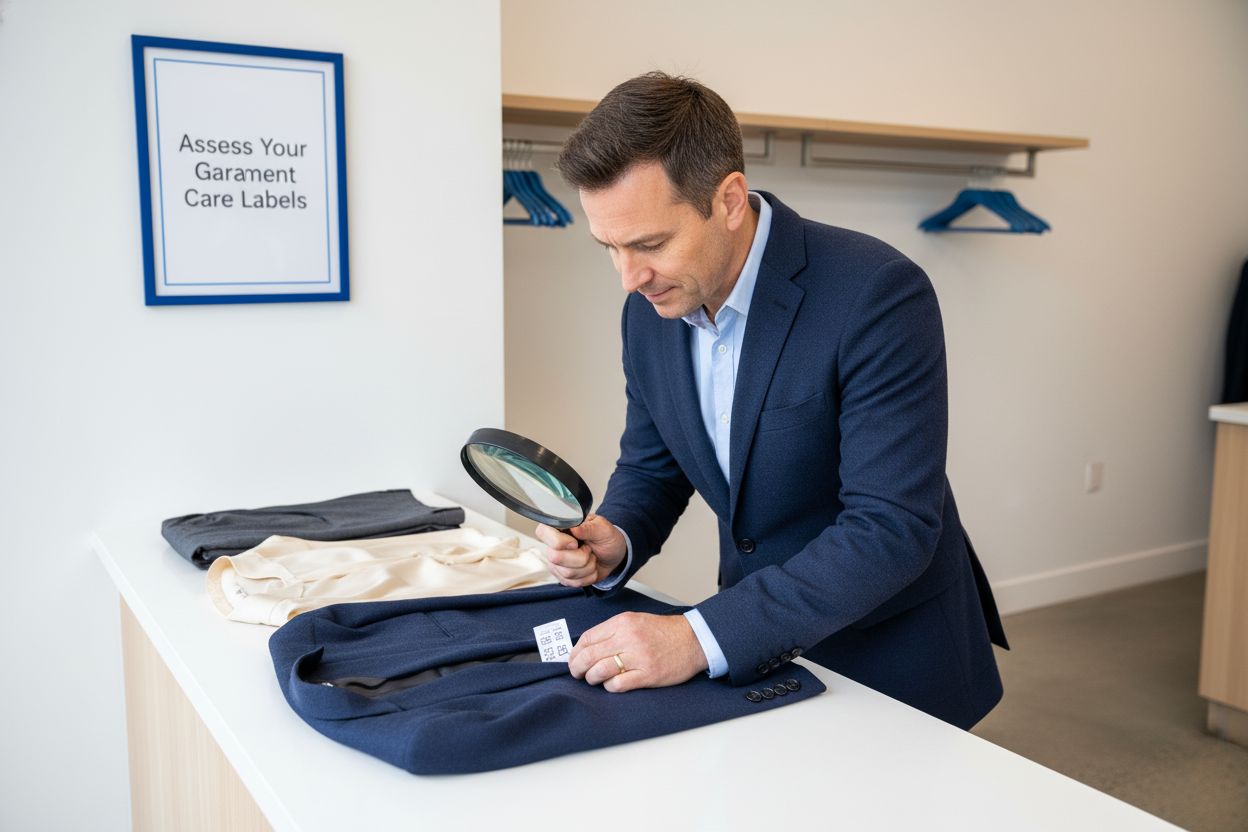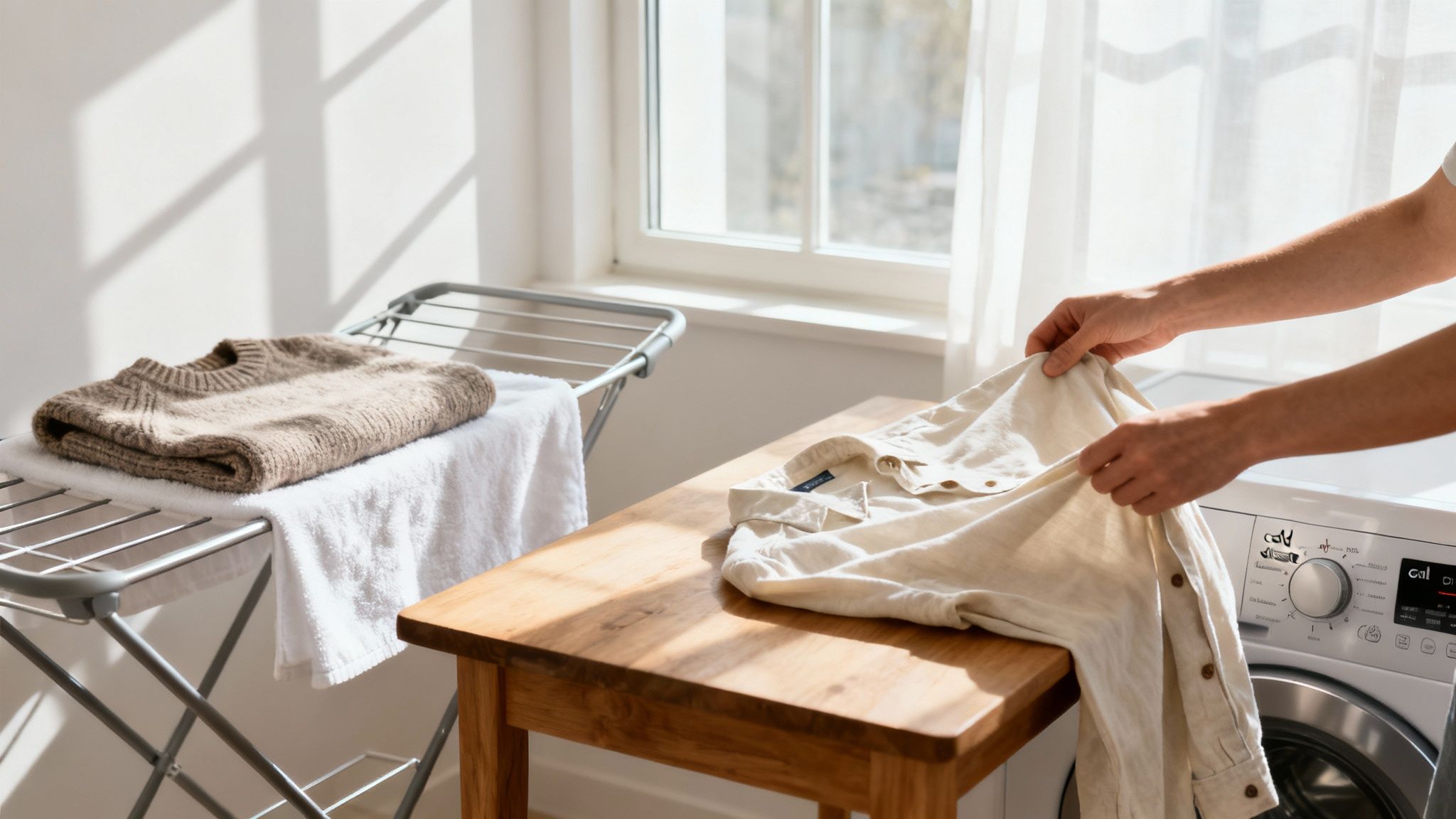How to remove color bleed from clothes: Simple fixes
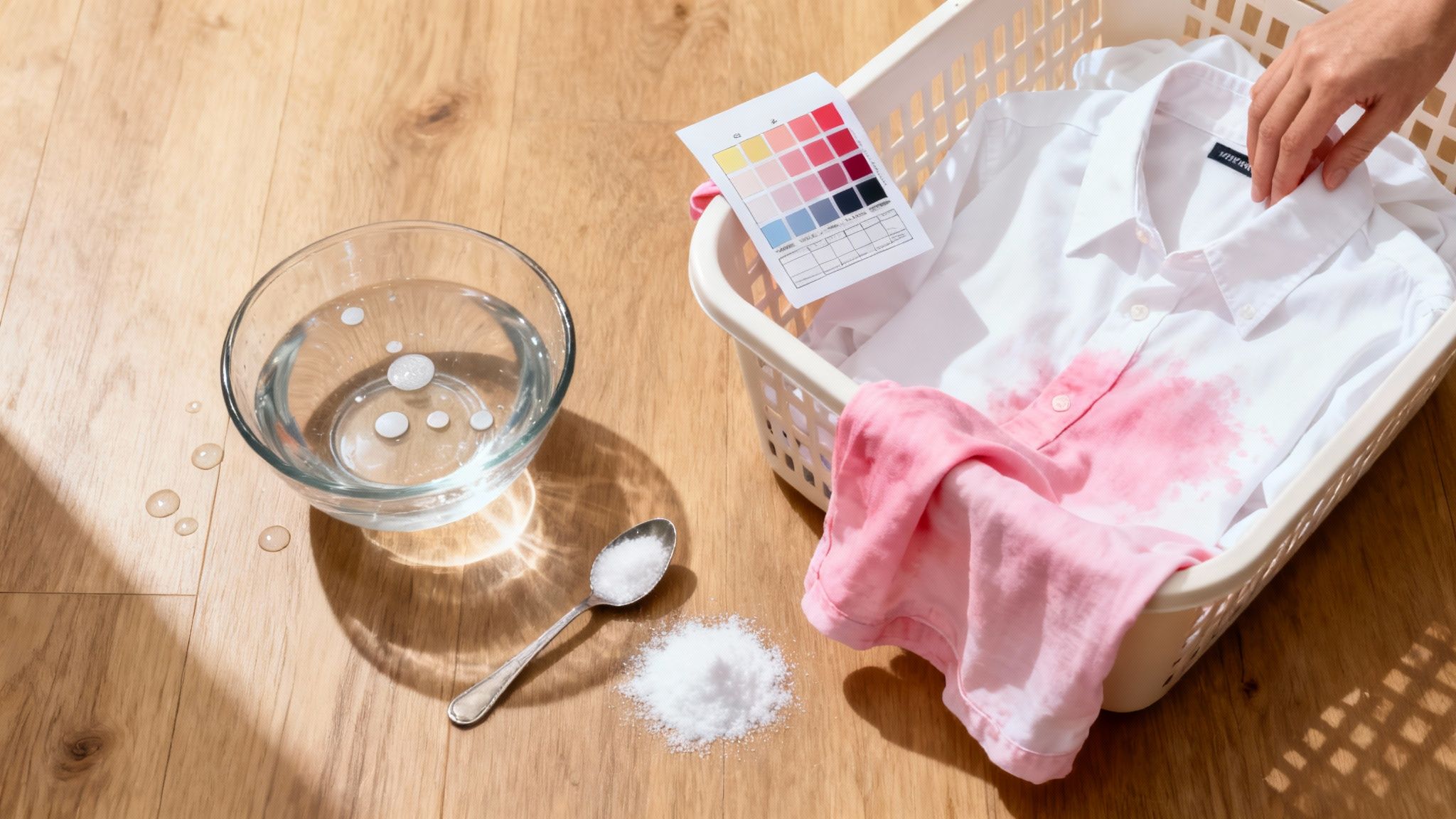
That sinking feeling is universal. You open the washer, expecting clean, bright whites, but instead, you’re staring at a load of laundry with a new, unwelcome pink tinge. A rogue red sock, maybe?
Your first instinct might be to sigh in frustration, but what you do in the next few minutes is critical. Acting fast is the single most important factor in saving your clothes from a permanent dye stain. The moment you spot the problem, the clock starts ticking.
Your Immediate Action Plan for Color Bleed
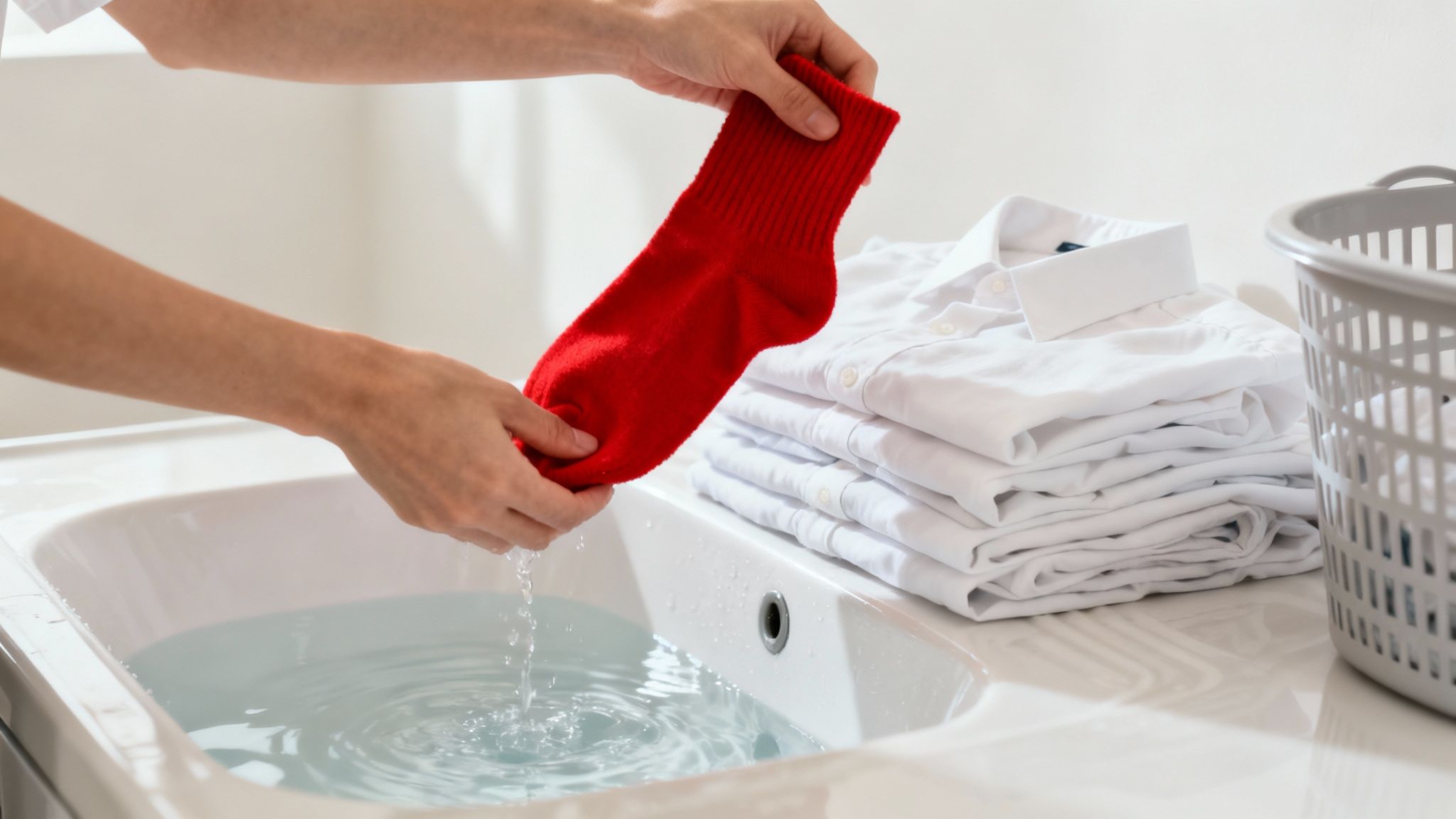
Don't Panic and Don't Even Think About the Dryer
Whatever you do, keep the stained clothes away from heat. This is the golden rule of handling color bleed. Tossing them into a hot dryer will effectively bake the stray dye into the fabric fibers, making the stain nearly impossible to get out later.
Your goal right now is to keep the affected items wet. This keeps the fabric fibers open and much more receptive to treatment.
Isolate and Separate Immediately
Time to play detective. Quickly sift through the wet laundry, piece by piece, and find the culprit. It's usually a new, brightly colored garment or a pair of dark-wash jeans that hasn't been washed before. Pull it out of the load right away to stop it from bleeding onto anything else.
Once you’ve found the source, create two separate piles: one with all the unintentionally dyed items that need immediate attention, and another with the clothes that escaped the disaster.
Your goal is triage. Isolate the bleeding garment, separate the stained clothes, and prepare to rewash the victims immediately. This simple separation prevents a minor inconvenience from turning into a major laundry catastrophe.
Rewash the Stained Items Right Away
Don't let those stained clothes sit around. Take the whole pile of affected garments and get them right back into the washing machine by themselves. A prompt rewash is your best line of defense.
- Go Cold: Always use a cold water cycle. Hot water will only encourage the unwanted dye to set permanently.
- Use Your Usual Detergent: Add your standard laundry detergent just as you normally would.
- Bring in Reinforcements: If the garment care labels allow it, add a color-safe oxygen-based bleach. This can dramatically improve your chances of lifting the stray dye without damaging the clothes' original colors.
Once the wash cycle is finished, pull each item out and inspect it carefully under good light. If the stains are gone, great! You can dry them as you normally would.
But if you still see faint traces of the unwanted color, keep the items wet and prepare for a more targeted soaking treatment, which we’ll cover next. This rapid response is truly the key to saving your laundry.
When you're faced with a sudden laundry mishap, it helps to have a clear game plan. Here’s a quick-reference guide to what you should—and shouldn't—do in the heat of the moment.
Color Bleed Emergency Dos and Don'ts
Keep these points in mind, and you’ll be in a much better position to reverse the damage before it becomes permanent.
Understanding Why Clothes Bleed Color
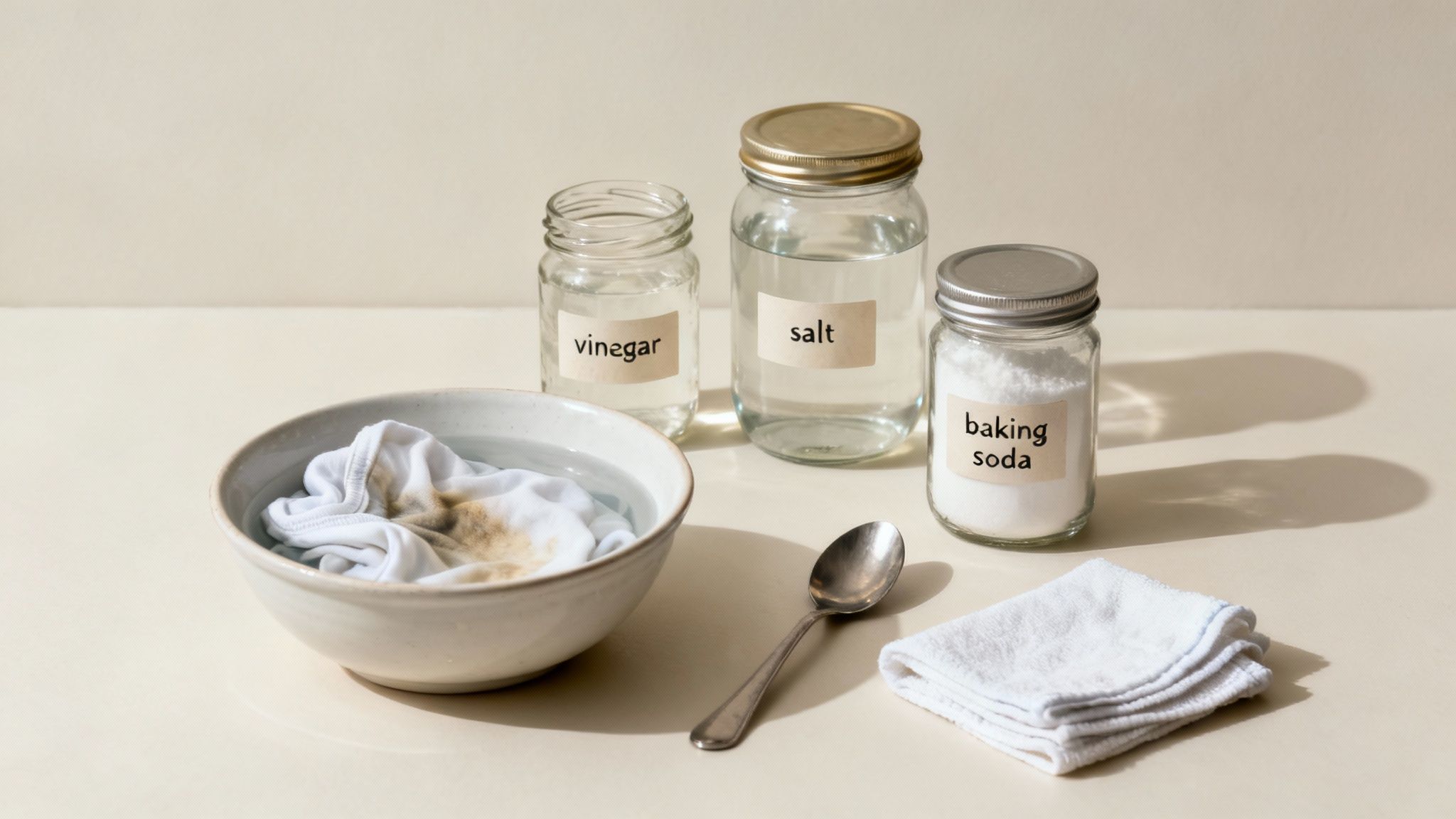
To really get a handle on removing color bleed, it helps to know why it happens in the first place. That frustrating moment when your white shirt turns pink isn't just bad luck; it’s a process called dye transfer. It happens when loose, unstable dyes from one piece of clothing wash out and grab onto another during the wash cycle.
Think about a brand-new pair of dark indigo jeans. To get that deep, rich color, they're loaded with dye. If that dye isn't perfectly bonded to the cotton fibres, some of it is guaranteed to escape, especially in the first few washes. Once those dye molecules are floating free in the water, they're looking for a new home—and your light-colored clothes are prime real estate.
The Role of Dyes and Fabrics
The heart of the problem is how well a dye sticks to a specific fabric. Natural fibres like cotton and wool are super absorbent, so they soak up dye beautifully. The flip side is that they're also more likely to release any excess dye that hasn't been properly set.
Synthetics like polyester, on the other hand, often need more complex dyeing processes to get those vibrant colors. The stability of these dyes can be a mixed bag, which is why some synthetics can be surprisingly bad bleeders.
A few things I've learned over the years:
- Red and orange dyes are notoriously unstable. They're the usual suspects in most color bleed disasters.
- New, dark garments are packed with the most loose dye. This is exactly why washing them separately for the first few times is non-negotiable.
- Hot water is the enemy here. It opens up fabric fibres, practically inviting the dye to run free. Cold water is your best friend for keeping colors where they belong.
The sheer scale of global textile manufacturing also plays a part. The textile dyes market is huge—it’s projected to hit USD 18.21 billion by 2033. With that much dye being used, it's a constant challenge for manufacturers to ensure perfect colorfastness, which is just the technical term for a garment's ability to resist fading or running.
How Manufacturing Impacts Your Laundry
Ultimately, the quality of the dyeing process is the single biggest factor. To keep prices competitive, some manufacturers might use cheaper dyes or take shortcuts during the fixation process—the crucial step where dyes are chemically bonded to the fabric.
Key Takeaway: Color bleeding isn't a random laundry mishap. It’s a direct consequence of unstable dyes, absorbent fabric types, and wash conditions like hot water that encourage dye release. Understanding this helps you make smarter choices in both treatment and prevention.
This means a gorgeous, brightly colored shirt might look great on the rack but lack the colorfastness to survive a wash. If you want to dive deeper into the properties of different textiles, you can find some great insight on various fabric materials. By knowing the "why" behind the bleed, you're much better equipped to fix the problem and stop it from happening again.
Using Household Remedies to Fix Dye Stains
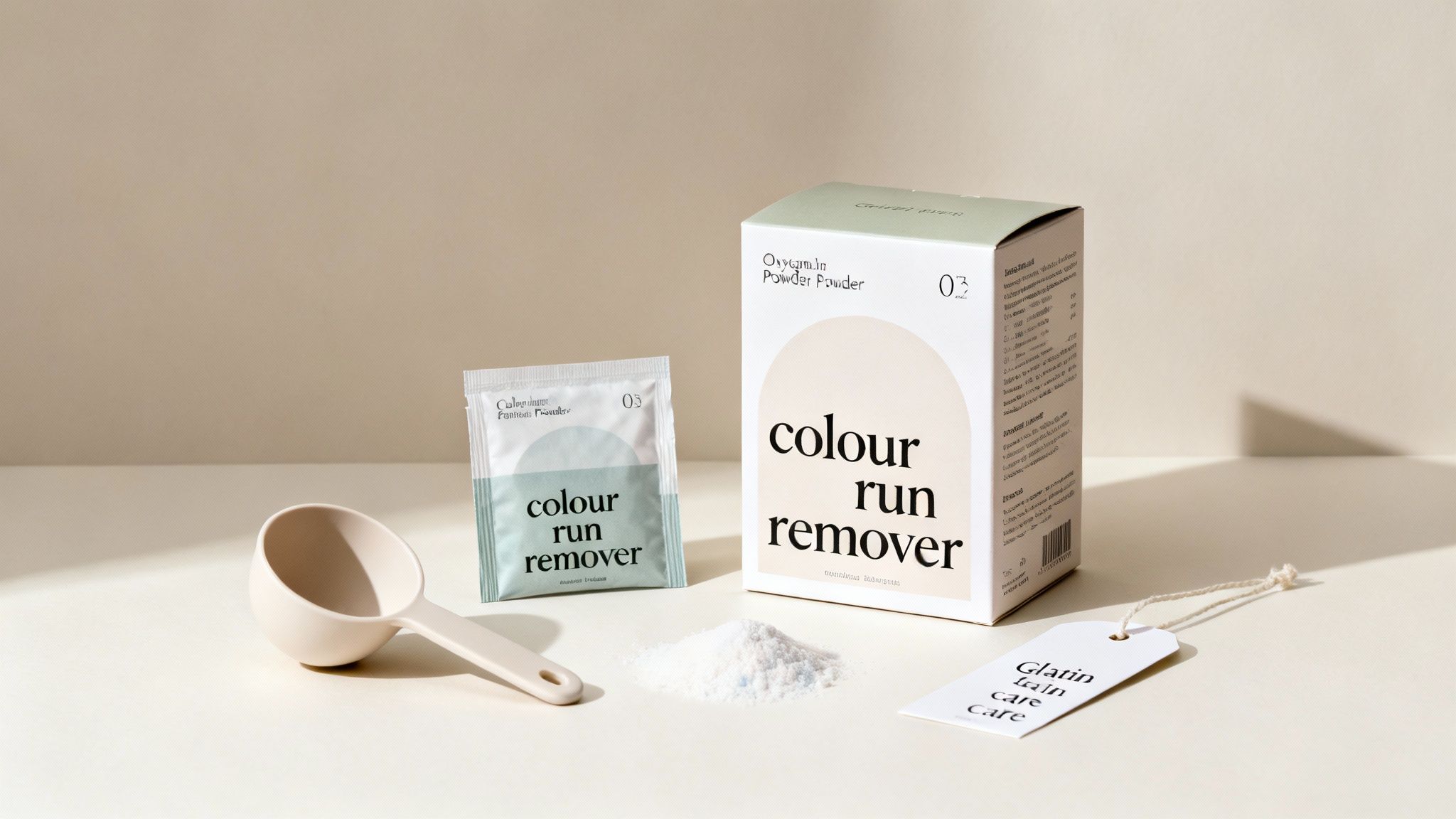
Before you reach for heavy-duty commercial products, take a peek in your kitchen pantry. You’d be surprised how often simple, budget-friendly staples you already own are the most effective first line of defense against dye stains. These remedies are much gentler on your clothes and are the perfect place to start when you've had a color bleed mishap.
It all comes down to using them the right way. You might have heard that vinegar and salt are used to set dyes, but in this case, they do the opposite. When used in a cold water soak, their properties help break down and lift away those pesky loose dye molecules that haven't bonded with the fabric yet.
The White Vinegar Method for Light Stains
Distilled white vinegar is a fantastic tool for faint dye transfers, especially on sturdy fabrics like cotton. Picture this: your new blue shirt has left a light, cloudy stain on a couple of your favorite white tees. A vinegar soak is exactly the kind of gentle fix you need.
The vinegar’s mild acidity gets to work loosening the unwanted color without damaging the garment’s original dyes.
- Mix up your solution. Pour one cup of distilled white vinegar into one gallon of cool water in a sink or washtub. Stick to white vinegar—apple cider or other types can leave their own stains behind.
- Let it soak. Get the stained item completely submerged in the solution. Give it about 30 minutes to really work its magic.
- Rinse and rewash. After the soak, give the garment a good rinse under cool water to wash out the vinegar. Then, just pop it back in the laundry on a cold cycle.
Always do a spot test first. Before you dunk the whole garment, find a hidden spot like an inside seam. Dab a little of your solution there and wait a few minutes. This quick check makes sure the fabric's original color won't be affected.
Using Salt or Baking Soda for Soaking
Salt and baking soda are two more kitchen heroes that can help pull out fresh dye stains. I find they work best as a pre-soak treatment to gently coax the rogue dye out of the fabric fibers before you try rewashing the item.
For a salt soak, just dissolve about a half-cup of regular table salt in a gallon of cold water. If you want to try baking soda, a good trick is to make a paste with a little water, apply it right onto the stained area for a bit, and then soak the whole garment.
These methods aren't as aggressive as chemical treatments, which is why I always recommend them as a safe first step. Now, if you're up against some really stubborn, set-in stains, you might need something with a bit more muscle. For those tougher jobs, looking into more advanced techniques like some of the popular laundry stripping recipes can give you the extra power needed to save your clothes.
Critical Tips for Household Remedies
Whichever home remedy you go with, a few rules of thumb will dramatically increase your chances of success.
- Act Fast. These methods work best on clothes that are still damp from the wash where the color bleed happened. Don't let that stain dry!
- Only Use Cold Water. Hot water is your enemy here. It will set that unwanted color right into the fabric, making it nearly impossible to get out.
- Be Patient. Let the item soak for the full recommended time. Rushing the process won't give the solution enough time to break down the dye.
- Air-Dry to Check Your Work. This is a big one. Never, ever put the garment in a machine dryer until you are 100% positive the stain is gone. Heat will set it permanently. Let it air-dry completely, check it in bright light, and if you see any lingering color, repeat the treatment.
Choosing the Right Commercial Color Run Remover
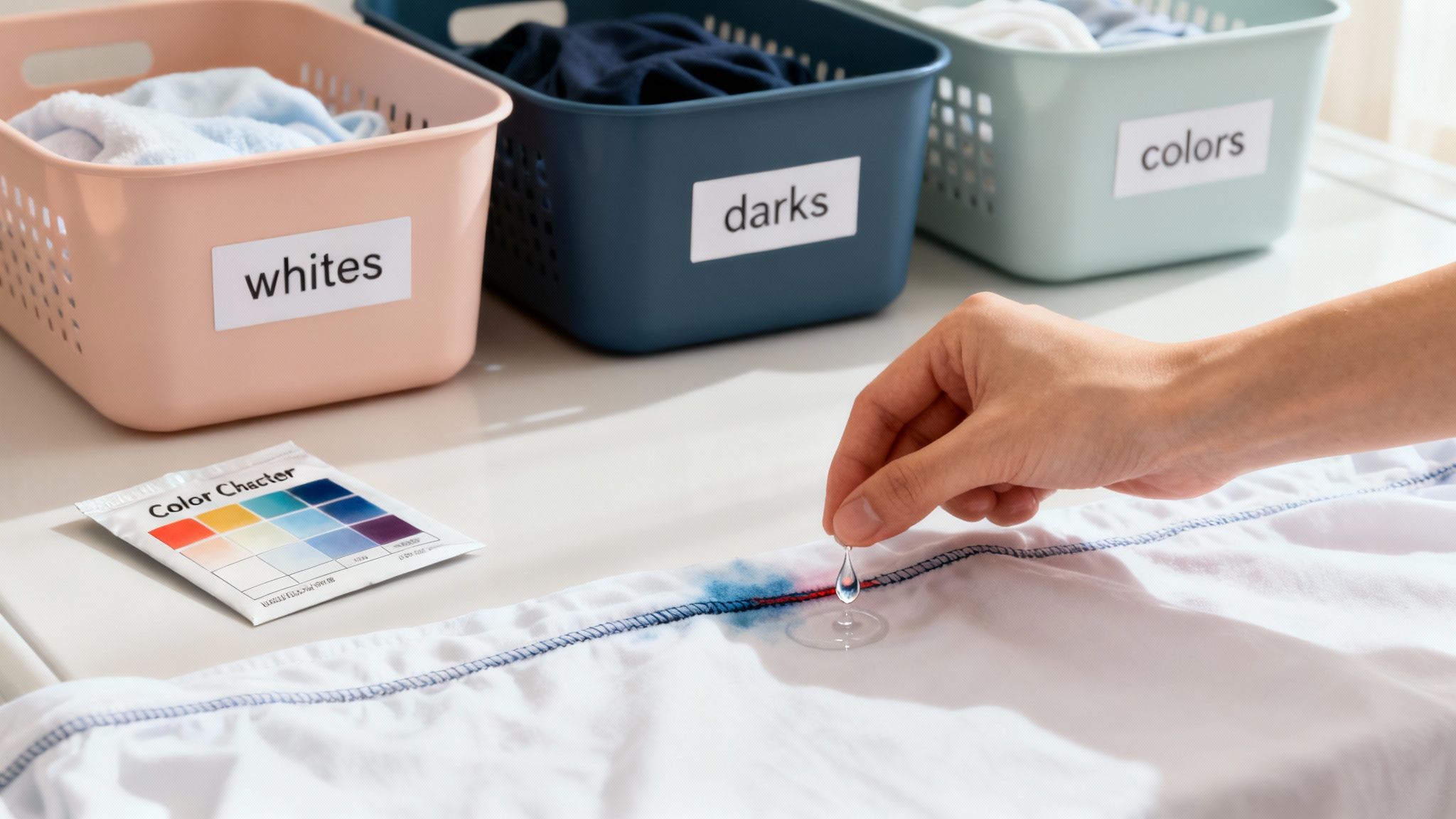
So, the vinegar soak didn’t quite cut it. When a serious dye transfer has turned your favorite shirt into a tie-dye experiment, it’s time to bring in the heavy hitters from the laundry aisle.
Walking down that aisle can feel a little overwhelming, but it really boils down to two main players: commercial color run removers and oxygen-based bleaches. These products are engineered specifically to hunt down and break apart those rogue dye molecules without stripping your garment's original, intended color.
Think of it like this: home remedies are your first-aid kit for minor scrapes. Commercial removers are the specialists you call for the bigger problems, like rescuing a crisp white button-down from a catastrophic red sock incident. They simply pack a more concentrated, targeted punch.
Oxygen Bleach vs. Chlorine Bleach: The Critical Difference
This is probably the single most important thing to get right before you buy anything. Grabbing the wrong bottle can instantly and permanently ruin your clothes.
- Oxygen-based bleach is your best friend here. You'll see it sold as "color-safe" or "all-fabric" bleach. Brands like OxiClean or Nellie's Oxygen Brightener use a compound called sodium percarbonate, which releases tiny oxygen bubbles in water to gently lift stains away. It’s safe for the vast majority of colored fabrics.
- Chlorine bleach is the classic, potent disinfectant you’re probably familiar with. It's fantastic for disinfecting, but it will strip the color out of nearly any fabric it touches. You should only ever use this on solid white, heavy-duty items like cotton sheets or socks when you're absolutely certain the fabric can handle its intensity.
For any color bleed disaster involving non-white clothing, always reach for oxygen bleach. Using chlorine bleach on colors is a one-way ticket to creating permanent white splotches and weakening the fabric.
Types of Commercial Removers and When to Use Them
Beyond the versatile oxygen bleaches, you'll also spot products specifically labeled as "color run removers." They come in a few different forms, each with its own ideal scenario.
Powders: These are usually the most potent formulas, designed for a good, long soak. You dissolve the powder in a basin or sink of water and let the stained item sit for several hours. This method is perfect for widespread, heavy dye transfer that has affected an entire garment.
Sheets and Pods: You’ve probably seen these—often called "color catchers." They're more of a preventative measure than a cure. You just toss one into a mixed-color wash, and its fibers are designed to trap any loose dye before it has a chance to settle on other clothes.
While they won't fix an existing stain, their popularity speaks volumes about how common this laundry mishap is. In fact, the global market for these little sheets is projected to hit $2.8 billion by 2033! It just goes to show how much we all want to keep our clothes looking vibrant.
To help you navigate the options, here's a quick breakdown of the products you're likely to find on the shelf.
Comparing Commercial Color Bleed Solutions
Ultimately, the right product depends on whether you're trying to fix a major dye catastrophe or just prevent one from happening in the first place.
Knowing how these different removers work on a chemical level is a huge advantage. They use very specific actions to target loose dyes, and that science is what makes them so effective. To dive a little deeper, check out our guide on how stain removers work for every stain type. This knowledge will empower you to pick the perfect product for your specific dye disaster and get the best results without causing any more damage.
How to Prevent Color Bleed in Your Laundry
Dealing with a laundry load full of pink-tinged "whites" is beyond frustrating. But the best way to fix a color bleed disaster is to prevent it from ever happening in the first place. Shifting from a reactive mindset to a proactive one is the secret to protecting your wardrobe. A few simple, consistent habits can save you time, money, and the heartache of a ruined favourite shirt.
It helps to understand the landscape we're in. The rise of fast fashion means we're seeing a massive influx of brightly colored textiles hitting the market and our washing machines. This isn't just a feeling; global apparel production has skyrocketed to support a colossal industry, meaning more dyes are being washed more frequently than ever before. This context makes smart prevention absolutely critical.
Build Smarter Sorting Habits
The single most important thing you can do is sort your clothes properly. It’s tempting to just toss everything in together on a busy day, but separating your laundry into distinct piles is your strongest defense against dye transfer.
- Sort by Color: This is the bare minimum. Create three piles: whites, lights, and darks. This simple act dramatically cuts the risk of a new pair of dark jeans turning your white t-shirts grey.
- Sort by Fabric Weight: To really level up your laundry game, separate heavy, abrasive fabrics like denim and towels from lighter items like t-shirts and blouses. This stops the rougher fabrics from rubbing against the delicate ones, a process that can physically loosen dye particles.
Proper sorting is a non-negotiable for laundry success. It’s a foundational step that professionals swear by, and you can learn more about why laundry services separate colors and why it’s so vital for garment care.
Implement a Quarantine for New Clothes
Brand-new clothes are the usual suspects. Garments with deep, saturated colors—think new red socks, dark blue denim, or a black sweater—are often loaded with excess dye that hasn't fully bonded to the fabric yet.
Pro Tip: Always wash new, brightly colored items completely on their own for the first one or two washes. Think of it as a "quarantine" wash. This allows the majority of that loose, unstable dye to rinse out safely, with no other clothes around to become casualties.
Use the Right Tools and Techniques
Beyond just sorting, a few strategic choices in your wash routine can make all the difference.
- Embrace Cold Water: Hot water is great for sanitizing, but it also opens up fabric fibers and encourages dye to escape. Unless you're dealing with greasy stains or disinfecting linens, washing in cold water is one of the most effective ways to lock in colors and keep them from running.
- Try a Bleed Test: If you're suspicious of a new garment, you can perform a quick test. Just dampen a hidden spot (like an inside seam) and press a white cloth or cotton ball against it for about 30 seconds. If you see any color transfer, you've got a bleeder. Wash it alone.
- Use Color Catcher Sheets: These are a fantastic insurance policy, especially for those mixed loads you can't avoid. You simply toss one of these special sheets into the wash, and it acts like a magnet, absorbing any stray dye particles floating around in the water before they can settle on other fabrics.
For a broader look at how to care for your clothes and sidestep common laundry mishaps, these general garment care instructions are a great resource.
Common Questions About Color Bleed Removal
Even when you think you’ve done everything right, a dye transfer can leave you with a ton of questions. It's easy to find conflicting advice online, but getting the facts straight is what will actually save your clothes. Let’s clear up some of the most common questions we hear.
Can I Remove Color Bleed After Clothes Have Dried?
This is the big one. It’s definitely tougher, but not always a lost cause. The real problem is the heat from a machine dryer—it basically bakes the stray dye into the fabric’s fibers, setting the stain.
If you’ve accidentally dried a stained garment, your best bet is a long, patient soak. Get a bucket or use your sink and fill it with cool water and a good oxygen-based bleach or a commercial color run remover. Submerge the item completely and just let it sit for at least eight hours. Overnight is even better. This extended time gives the solution a real fighting chance to break down that set-in dye.
After the long soak, wash the item again like you normally would and see how it looks. You might have to repeat the process a couple of times, but as long as you see the stain getting lighter, you know you're making progress.
Crucial Reminder: Whatever you do, keep that garment out of the dryer until the unwanted color is completely gone. Air-dry it between treatments so you can safely check your work.
Will Vinegar or Salt Permanently Set the Stain?
This is a huge myth that causes a lot of laundry room anxiety. It’s true that textile manufacturers use agents like vinegar and salt to set dyes, but that’s during a highly controlled, high-heat production process. In your home washing machine, the effect is totally different.
When you use a little white vinegar in a cool water soak, its mild acidity actually helps release the loose, unwanted dye molecules from the fabric. Salt works in a similar way, helping to lift the stray color out. Think of them as a gentle first-aid treatment for a fresh stain, not a way to make it permanent.
Are Color Catcher Sheets Good for Existing Stains?
Color catcher sheets are brilliant for prevention, but they can't undo damage that's already done. They're a proactive tool, not a reactive one.
During a wash, they act like a magnet for any loose dye floating around in the water, soaking it up before it has a chance to settle on your other clothes. Once a stain has already bonded to the fabric fibers, though, a color catcher sheet can't pull it back out. For an existing color run, you'll need a targeted approach like a dedicated soaking treatment or a product made specifically for color run removal.
When Should I Take Stained Clothes to a Dry Cleaner?
Sometimes, the smartest move is to admit defeat and call in a professional. There are a few scenarios where you should head straight to the dry cleaner instead of trying to fix it yourself.
- Delicate Fabrics: If the stained item is silk, wool, rayon, or anything with a "Dry Clean Only" tag, don't even think about home remedies. The risk of ruining the fabric's texture or causing more damage is just too high.
- Stubborn Stains: You've tried a soak or two on a sturdy fabric like cotton and the stain isn't budging. It’s time to stop. Pushing it further with more home treatments could start to weaken the fabric itself.
Professionals have access to specialized solvents and cleaning techniques that are way more powerful than anything you can buy at the store. They can often save a garment that seems like a lost cause.
If a stubborn dye transfer has you stumped, or you're dealing with delicate fabrics that can't risk a home remedy, let the professionals handle it. Columbia Pike Laundry offers expert dry cleaning services that can often rescue garments you thought were lost. Reclaim your time and save your clothes by scheduling a hassle-free pickup at https://columbiapikelaundry.com today.
Popular Blog Articles

Meet the Author
Daniel Logan didn’t start CPL because he loved laundry. He started it because his family was drowning in time debt, and laundry was one of the biggest weights.
Mornings were chaos with two kids under 5. Evenings felt like catch-up. And weekends? Gone to sorting socks and folding piles.
He knew his story wasn’t unique. So he built a business that gave families like his just a little bit of breathing room one load at a time.
With no laundry experience but deep tech skills, Daniel rolled up his sleeves, doing every job himself while building systems that turned it into a modern laundry service that saves customers time, simplifies their lives, and delivers reliability they can count on.
That’s where CPL began. Not from a playbook, but from pain. From one dad trying to buy back time: for himself, and for every household like his.


